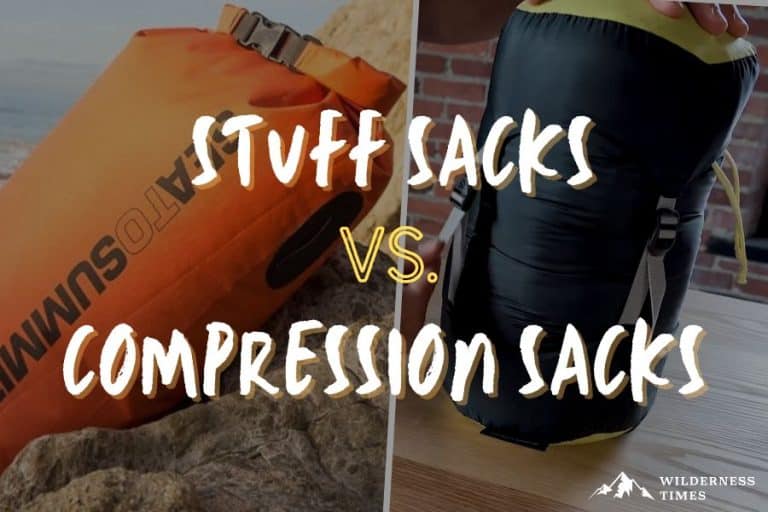When you’re out on the trail or at a campsite, it’s super important to keep your gear organized and compact. That’s where the question of stuff sacks vs. compression sacks comes in!
Which is better? Well, they each have their pros and cons.
The quick version: Stuff sacks are best for organization. Compression sacks reduce the size of your bulkier items.
In this article, we will take an in-depth look at both options to help you decide which is best for your camping needs.
Let’s get into it!
Table of Contents
ToggleStuff Sacks Vs. Compression Sacks: A Head-To-Head Comparison
First off, let’s do a direct comparison of stuff sacks vs. compression sacks.
Here are some quick factors you should consider before purchasing one or the other:
FEATURES | STUFF SACK | COMPRESSION SACK |
Packing Effeciency | ||
Portability | ||
Durability | ||
Affordability | ||
Accessability |
Stuff Sacks
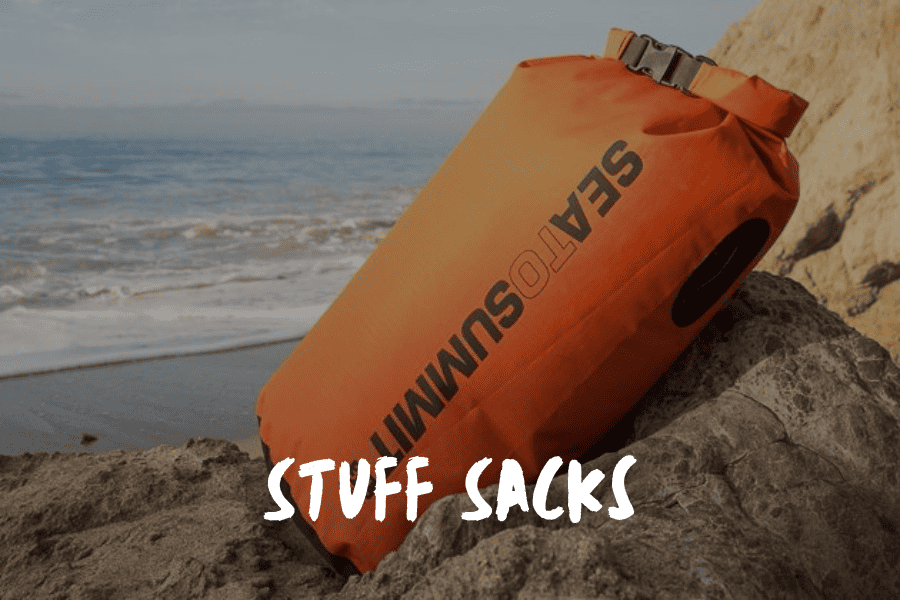
In a nutshell, a stuff sack is a bag that you can use to store clothing, gear, and other soft camping items in your backpack.
Types Of Stuff Sacks
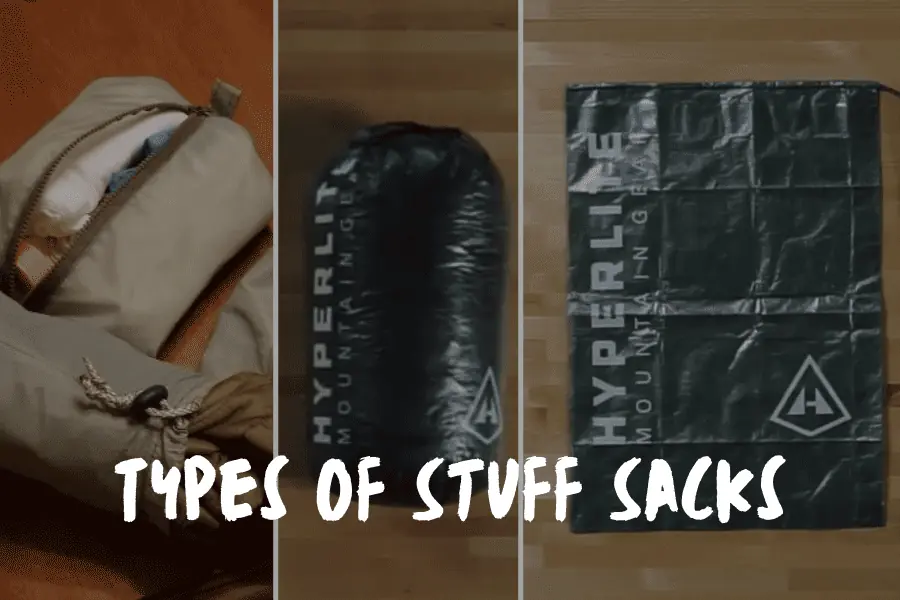
There are multiple types of stuff sacks, including drawstring, roll-top, and zippered.
The main difference between these types of stuff sacks is how they open and close at the top.
Roll-top and zippered stuff sacks are generally more efficient at keeping dirt out because their closures are more secure.
Drawstring bags are not as effective because their openings always have a small hole where the strings fasten down.
Plus, the drawstrings are likely to loosen as the day wears on.
Benefits Of Stuff Sacks

Stuff sacks are a great way to store and organize your gear in your pack during a longer backpacking trek.
When I’m on the trail, I organize my clothing in different colored stuff sacks, so I know where everything is in my pack.
This makes it even easier to grab the gear I need on short notice.
Downsides Of Stuff Sacks
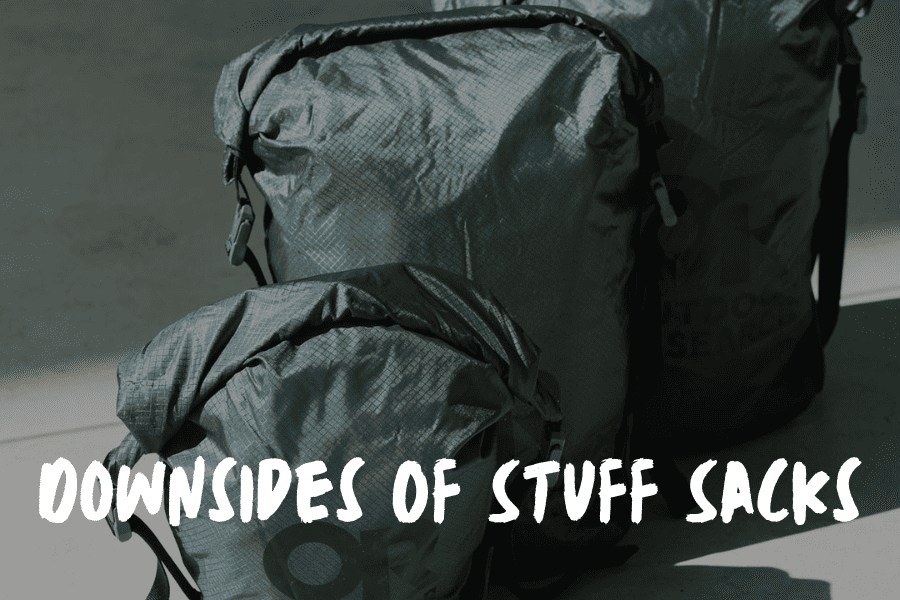
Outside of general organization, stuff sacks do not compress their contents.
They will always have a bulkier shape than compression sacks, which can take up precious room in your pack.
Because of this, I use them for a separate purpose than I would use compression sacks.
Ideal Items For Stuff Sacks
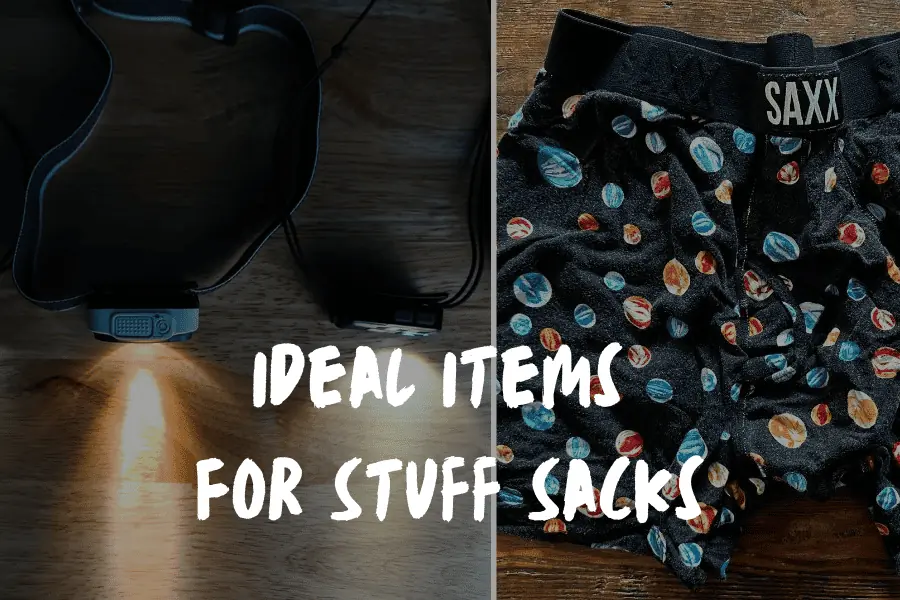
Stuff sacks are great for soft gear – including clothing, headlamps, outer layers, and food.
If you end up using a stuff sack for food, just make sure you don’t re-use that same bag for clothing.
Otherwise, you’ll put food smells on your clothing, which can attract critters to your gear.
Compression Sacks
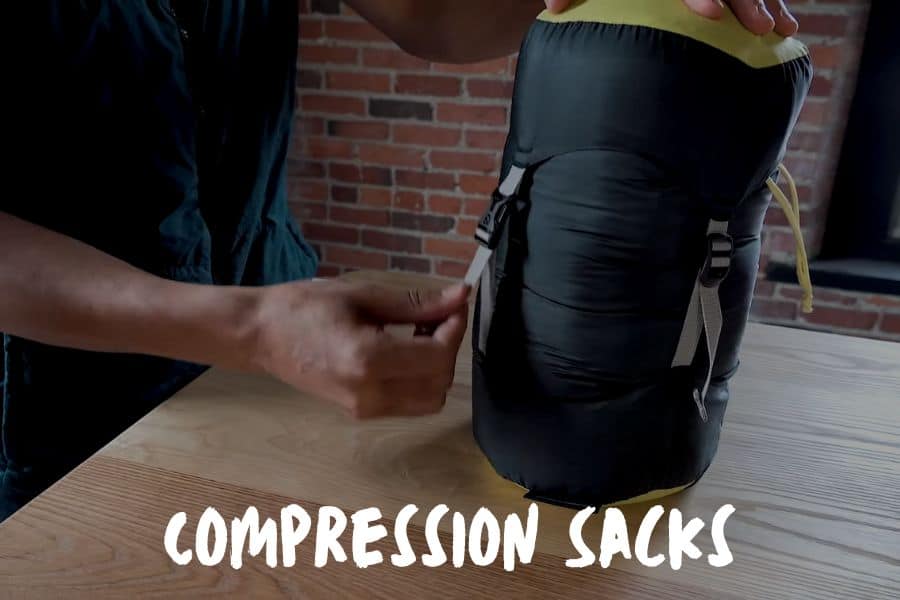
Compression sacks are bags that condense their contents, making them smaller.
They are a great tool to have on longer treks and are used primarily for reducing the size of your sleeping bag in your pack.
Types Of Compression Sacks
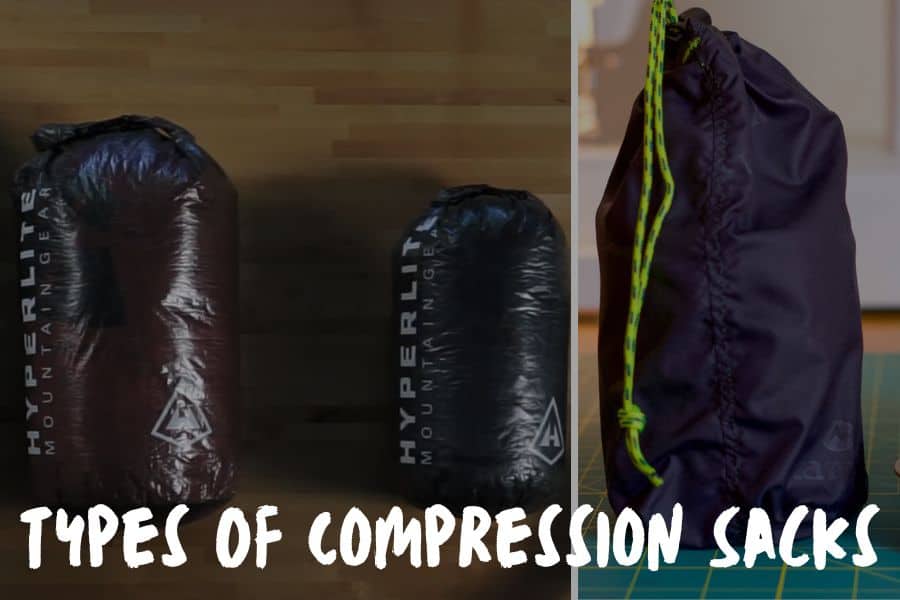
There are a few types of compression sacks, including roll-top, vacuum-sealed, and drawstring.
While the closing of compression sacks is similar (if not identical) to stuff sacks, it’s the pull straps that make all the difference.
Generally, compression sacks will have two pieces of fabric that cover the top (a.k.a. the “cap”) and bottom of the sack.
These pieces of fabric are connected by straps that you pull to bring the top and bottom pieces together.
This squishes the contents between the top and bottom, making the bag smaller.
Benefits Of Compression Sacks
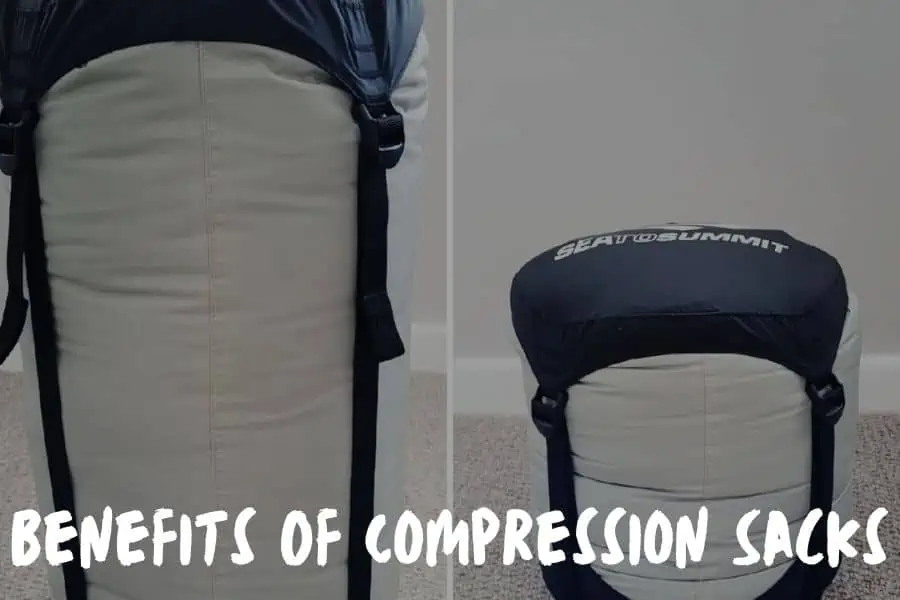
As their name suggests, compression sacks make soft contents much smaller than they would be on their own.
Because of this, using compression sacks can afford you more room in your pack.
Downsides Of Compression Sacks
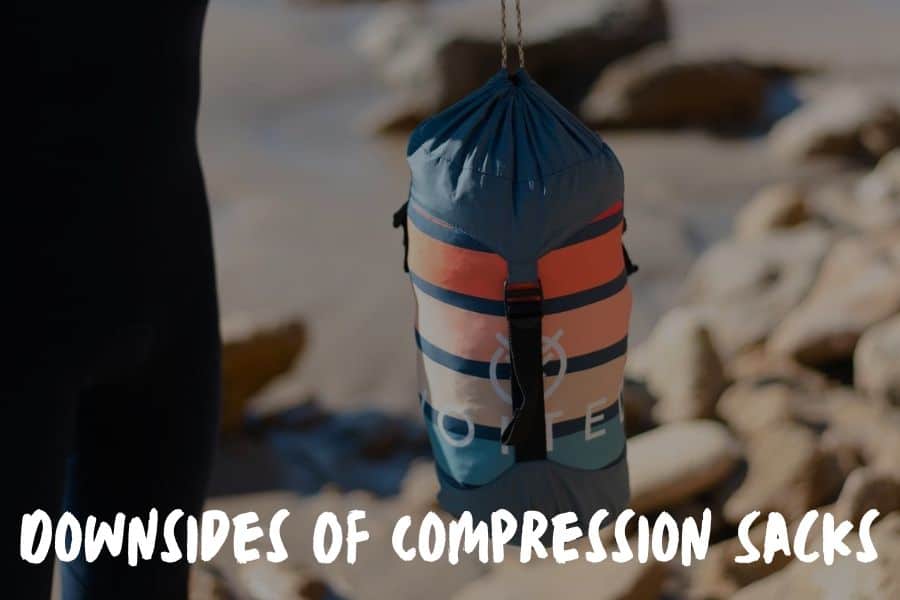
It can be tempting to use compression sacks for everything you pack – resist this urge!
Because compression sacks make items smaller, it can be easy to forget that their items will still weigh the same after they are condensed.
Plus, when there is more room in your pack, it can be tempting to overpack.
Therefore, it’s important to use compression packs sparingly, so you don’t add too much extra weight to your pack.
Additionally, it can be detrimental to store your sleeping bags in compression sacks long-term.
Too much long-term compression can damage insulation and padding.
When you get home, make sure to take your sleeping bag out of its compression sack and store it neatly and loosely folded!
Ideal Items For Compression Sacks
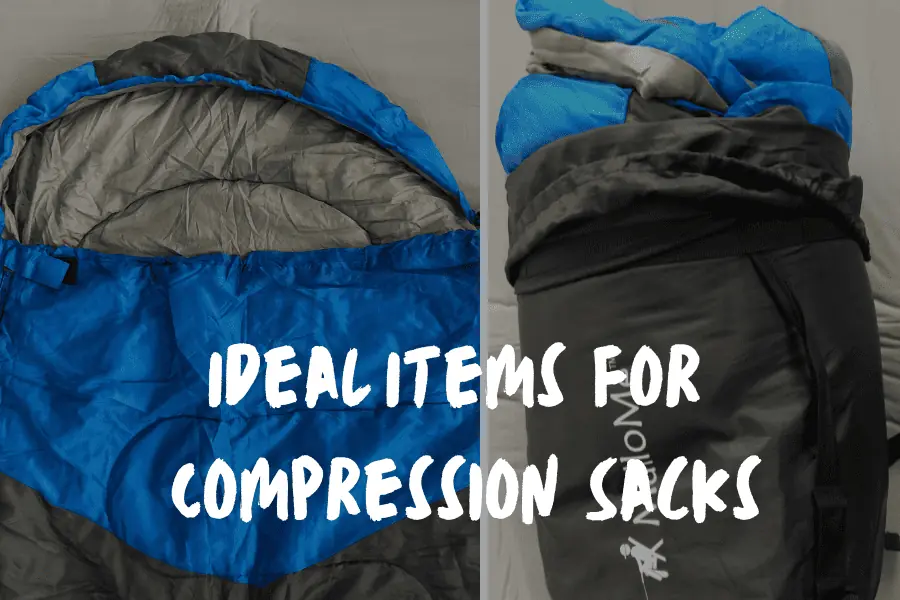
The best thing to use a compression sack for is your sleeping bag, which tends to be bulkier without it.
You can also use them for clothes, especially bulkier layers.
Choosing The Right Sack For The Job
There are a few factors to consider when picking between a stuff and a compression sack.
Use this section, as well as the table above, to choose the bag that’s right for you!
It’s also worth noting that one camper can use both types of bags on the same outdoor adventure.
They have different purposes, after all. Using both types of sack in tandem can make for an efficiently packed backpack.
Main Factors For Consideration
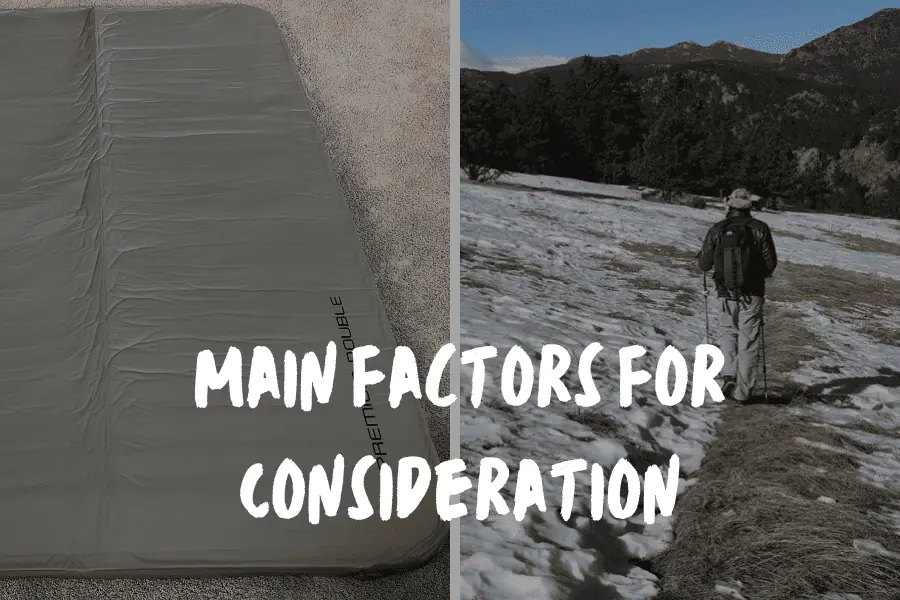
When deciding between a stuff sack and a compression sack, it’s important to consider the following logistical criteria.
Gear Size
Compression sacks are built to make your bulkier pieces of gear a more manageable size for your pack.
In comparison, stuff sacks won’t necessarily make your gear much smaller than before.
- Use a stuff sack – for organizing soft gear, like clothing, that’s already tightly packed.
- Use a compression sack – for making a bulky piece of gear smaller and more compact for your backpack.
Trip Duration
Both stuff sacks and compression sacks will stand up well over long periods of time, although compression sacks are generally more durable (and usually water-resistant).
Compression sacks are more likely to hold up longer over time and are better for storing your more valuable items on a long trip.
- Use a stuff sack – for less valuable items, or items that can get wet without taking on too much damage.
- Use a compression sack – for your more valuable items, or items that get damaged when wet, like your sleeping bag.
Matching Sack Type To Gear Type
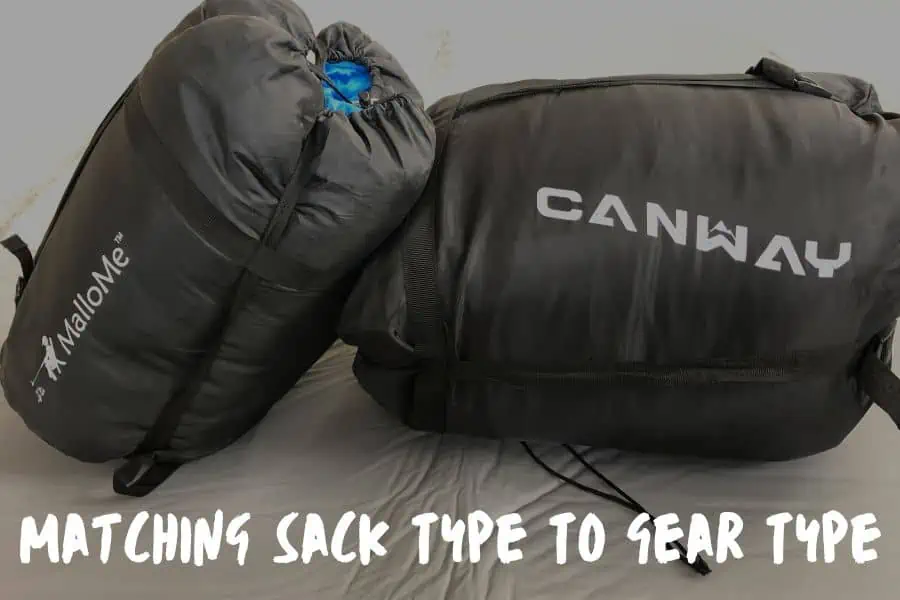
It’s best to use your stuff sack for your softer gear, like your clothing and fleeces, and your less valuable items.
Stuff sacks are less water-resistant, too, so make sure that whatever you pack in them can get damp.
In comparison, compression sacks are generally made with more water-resistant materials and fabric.
So, they’re better for your more valuable or water-sensitive gear.
And, as always, compression sacks will make bulky items smaller and are best for larger pieces of soft gear that needs to be minimized.
Assessing Personal Preferences & Priorities

When it comes down to it, the type of bag you use depends on your personal preferences and priorities.
You can get away with not using a compression sack for your sleeping bag, but you save more space in your pack with one.
So, if you like one type of bag for your gear more than another – go for it!
Evaluating Cost & Durability
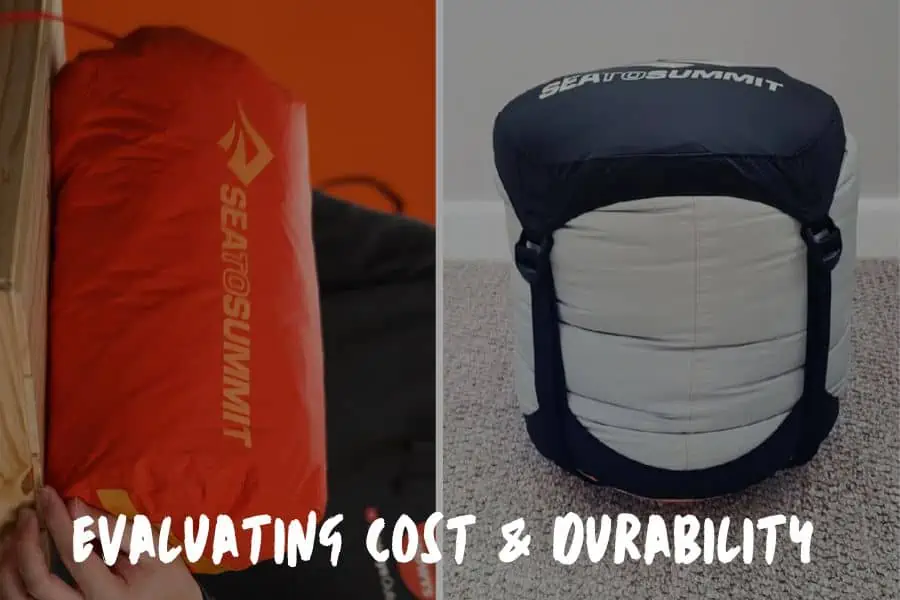
Compression sacks are generally more expensive than stuff sacks.
They use more water-resistant, durable materials and use extra fabric for the straps. So, it makes sense they cost a bit more.
Though, this cost is worth it if you have items that must be condensed to make your longer treks more comfortable.
Tips & Best Practices
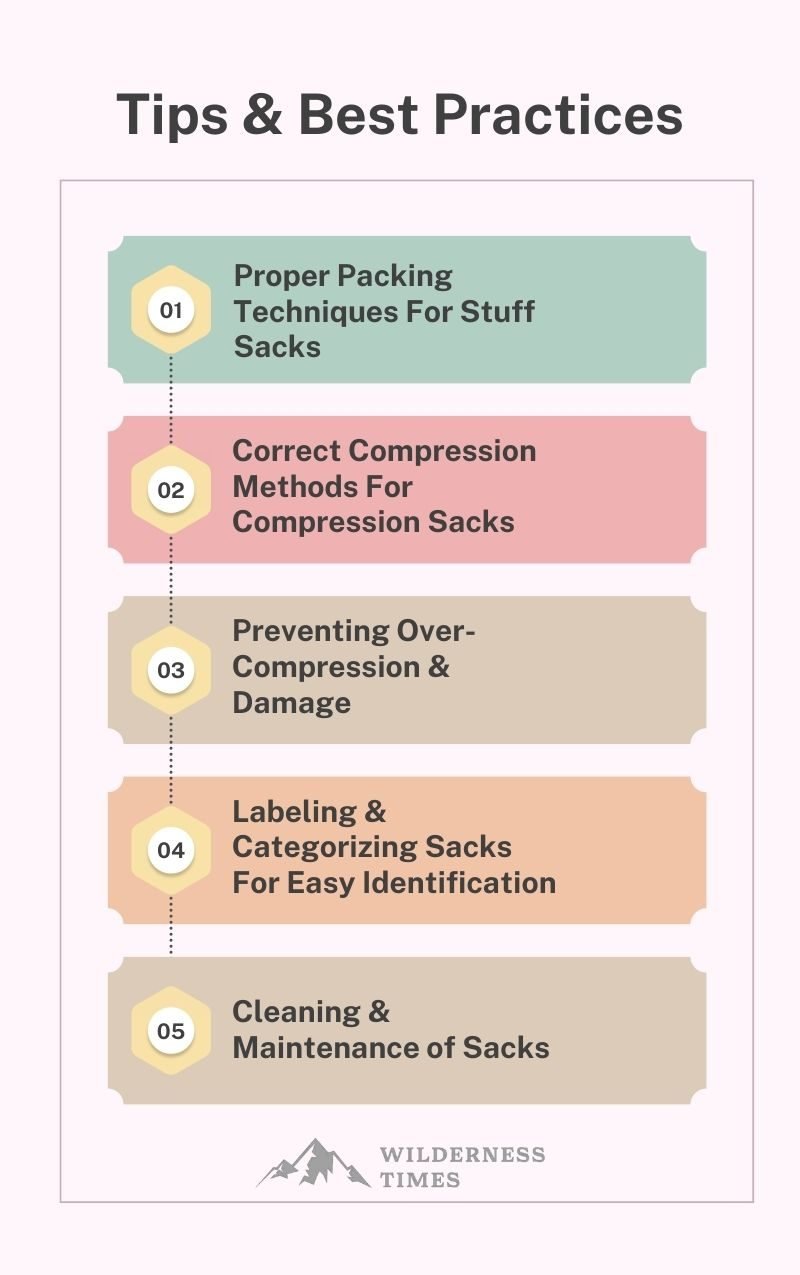
Proper Packing Techniques For Stuff Sacks
When you’re packing clothing in stuff sacks, it’s important that things are as neat and orderly as you can get them.
I do this by rolling my clothing, rather than folding them, before placing them in the stuff sacks.
Rolling your clothing will save space and keep things organized in your pack.
Correct Compression Methods For Compression Sacks
To get your sleeping bag into the compression sack, all you have to do is – you guessed it – stuff it into the compression sack.
Don’t worry too much about folding the bag up in any particular shape before stuffing it.
I recommend you start your stuffing from the toe box end of the sleeping bag.
This is up to preference, but I generally like having the top of the sleeping bag near the opening.
This way, I can have something to grab onto when taking my sleeping bag out at the campsite.
Once your sleeping bag is fully in the bag, it’s time to compress!
Put the “cap” of the compression sack and use your weight to push down on the sack. Then, pull all of the slack out of the traps.
Watch the video above to see this in action!
Preventing Over-Compression & Damage
It can be tempting to compress down your sleeping bag until it’s as small as possible in your backpack.
But over-compression can be damaging to your sleeping bag’s insulation.
If packed down too tightly, the insulation can shift and become less efficient.
Because of this, it’s best to compress down your sack to where it naturally stops.
If you’re huffing and puffing trying to make your compression sack’s straps tighter, you’re likely over-compressing it.
Labeling & Categorizing Sacks For Easy Identification
If you’re using stuff sacks to store and organize your gear, I recommend using different color sacks to distinguish between the bags.
Some campers also like to write labels on their bags, although it’s not necessary if your bags are different colors.
However, I absolutely recommend labeling your stuff sacks if you store food in them.
Food particles and smells can linger long after we stop smelling them ourselves.
So, make sure you keep a dedicated food bag from one campout to another.
Overall, I recommend buying stuff sacks that are lighter in color.
This will make it easier to see them when you look into your pack.
Cleaning & Maintenance Of Sacks
Both stuff and compression sacks are fairly straightforward when it comes to cleaning and maintenance.
If you see any dirt or grime on your stuff sack, you can wipe it off with warm water and a cloth.
If the sack requires more cleaning, then you can hand-wash it with a non-detergent soap and hang it to air dry.
Most sacks have some level of water-resistant coating on their exteriors.
To protect this coating – plus the interior contents of the bags – do NOT use the washing or drying machine to clean your sacks.
The extra heat and water from machine washing can ruin these coatings and stretch the fabric.
FAQs
Can I Use A Stuff Sack As A Makeshift Pillow While Camping?
Absolutely! All you need to do to make a pillow is stuff the sack with extra clothing and fleece.
Can Using A Compression Sack For My Sleeping Bag Affect Its Insulation Properties?
It depends. Storing your sleeping bag in a compression bag for a short period of time will not damage the insulation.
You won’t have to worry about your bag getting damaged on a longer trek.
However, storing your bag in its compression bag for a long period of time can damage the insulation.
Therefore, when you get back home, make sure to fold up your bag more loosely in a large bag, rather than storing it in the compression bag.
Are There Any Alternative Uses For Stuff Sacks Beyond Organizing Gear?
While a stuff sack is mostly used for organization, they can be used for other purposes – if you’re feeling a little creative and short on room.
As mentioned above, you can forego bringing a camping pillow and just stuff your stuff or compression sack with clothes or soft items to make one.
They can also be used to store dirty laundry throughout your trip.
I have also seen them used to store trash during a longer trek without frequent dumpsites.
Lastly, if you find a stuff sack with a good enough water-resistant coating, they can be an effective dry bag for your electronics.
Can Compression Sacks Be Used To Protect Delicate Items During Travel, Such As Souvenirs Or Fragile Electronics?
While compression sacks can help store away your fragile items, they don’t necessarily protect them.
This is because they do not have additional padding.
Therefore, if you’re just looking to sequester your fragile items in your luggage, compression sacks can be a good idea.
If you have especially fragile items, I recommend wrapping the compression sack in a few layers of clothing.
How Can I Prevent Stuff Sacks Or Compression Sacks From Developing Odors Or Musty Smells Over Time?
The best way to prevent bag smells in your stuff or compression sacks is to ensure that there is no moisture left over in them before you store them away.
When you get back from your trip, make sure that your stuff sack is completely dry before storing away.
I recommend hanging it up in a sunny spot for an hour or two before folding it up for storage.
Are There Any Recommended Storage Methods For Stuff Sacks Or Compression Sacks During The Off-Season?
When you’re storing away your stuff sack, make sure to lightly fold your bags up before storing in a cool, dry environment.
The goal of this storage environment is to ensure that the sack doesn’t get wet while in storage, either from water or excess moisture in the air.
Can Using Compression Sacks For Gear Contribute To Weight Distribution & Balance While Backpacking?
Yes. Compression sacks concentrate weight. But this means they allow you to distribute and balance your bag more effectively.
When you’re packing your bag, I recommend packing your sleeping bag at the very bottom of your pack. This is the ideal placement for a few reasons.
First, your sleeping bag (even in a compression bag) will take up a good portion of space.
Having it concentrated at the bottom of your bag will give you a good base for the rest of your things.
This placement is also near your center of gravity, so it’ll help keep your weight well-distributed between you and your bag.
Second, most backpacking bags will have a zipper at the bottom of the bag to give you access to the lower-down items.
This makes it so you don’t have to unpack your whole backpack just to get to those things.
If your sleeping bag is placed near this zipper, you can have quick access when you arrive at the campsite.
Final Thoughts
Whether you need better organization or more room in your pack, both stuff and compression sacks are helpful tools.
Ultimately, there is no better option when comparing stuff sacks vs. compression sacks.
It is all up to what you need and when.
I hope you now understand the differences between the two types of bags and when you should use each one.
And, as always, happy camping!
Also Read:


